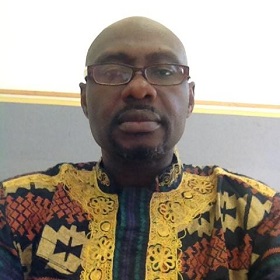The number of Ebola hemorrhagic fever victims is rising with every passing day. According to the WHO data, there are more than 13,7 thousand people infected by the virus. We asked experts from African countries to share their opinion on whether the Ebola outbreak can unite mankind. Okolo Ben-Simon, Executive Director of the African Centre for Human Security, Peace and Sustainable Development (Nigeria) and Tity Agbahey, Junior Fellow from the Institute for Security Studies (Senegal) express their view with this respect.
The number of Ebola hemorrhagic fever victims is rising with every passing day. According to the WHO data, there are more than 13,7 thousand people infected by the virus. We asked experts from African countries to share their opinion on whether the Ebola outbreak can unite mankind. Okolo Ben-Simon, Executive Director of the African Centre for Human Security, Peace and Sustainable Development (Nigeria) and Tity Agbahey, Junior Fellow from the Institute for Security Studies (Senegal) express their view with this respect.
Ebola Virus Disease: A Call for International Cooperation
Okolo Ben Simon, Executive Director, African Centre for Human Security, Peace and Sustainable Development (AFRISDEV).
When in March 2014 in ‘faraway’ Guinea, West Africa, the Ebola Virus Disease (EVD) claimed its first victim many in the world did not take notice. It would take more than four months and about 2000 lives lost to the disease before the world started taking notice. At the time of writing (late October 2014), the death toll is around 4,890 (according to WHO database) and is still growing. Even then, it was mainly seen and treated as an African disease, restricted to the area of West Africa. Understandably, the World Health Organization (WHO) and a few Western countries made the usual commitment to ‘assist’ the region in tackling the scourge of the virus. There were debates over the ethics of the use of non-approved drugs for the possible treatment of EVD. The understanding then was that ZMapp, a drug manufactured in the USA, was efficacious in treating the symptoms of the disease. However, while the debate was on, many continued to die, especially in West Africa. Conspiracy theories of Africa being used as a testing ground for bioweapons were abundant.
While the virus was first discovered in 1976, it was considered localized to the Democratic Republic of Congo (Former Zaire) and Sudan. The origin of the virus has been traced to fruit bats, monkeys, chimpanzees and forest antelopes found ill or dead. It is known to spread from animal to human and from human to human, through body contact, and especially through the exchange of body fluids including sweat. What makes the disease so deadly is not just that there has been no known cure (fatality occurs between 50 – 90% of the time), but the fact that it leads to death within a few days of its manifestation (Death normally occurs between 2 – 21 days after contacting contagious species or people).
With the disease’s eventual migration to the shores of Europe and the USA, it dawned on many that it couldn’t be effectively contained within the borders of West Africa or Africa generally. This seems to have activated a race amongst the world leading medical laboratories to manufacture a cure and a vaccine that will tackle this deadly disease. Its migration to Europe and the USA has proven that it does not discriminate between either rich or poor countries. This is a good enough motive for international cooperation in the eradication of the disease.
While the world may be at crossroads on how best to approach other challenging issues like terrorism, insurgency, piracy, militancy etc., it will be safe to argue that public health and security challenge presented by the EVD calls for international cooperation. The security threat of EVD is even more imminent given the fact that some terrorist organizations and even states invest in biological weapons. Not only is Ebola a highly contagious infectious disease, the virus which causes it has the potential of being used as a bioweapon. If discounting the risks involved, terrorist organizations like Al Qeada, Boko Haram, ISIS, etc. were to get hold of the pathogens of Ebola, they may use it as bioweapon against their enemies.
Notwithstanding the understandable disappointment felt by many concerning the ineffectiveness of the UN, it still remains a veritable tool for harnessing states’ cooperative effort in the race against the EVD. There is no doubt that the public health and security threat posed by the EVD requires international cooperation to achieve the goal of eradication of this deadly disease. The closure of borders and suspension of flights from Ebola ravaged countries will not solve the problem.
The UN Security Council and other leading countries need to show political will in tackling this disease. They must put aside other issues of divergence amongst them and unite their efforts in addressing this very challenge. It is equally hoped that the EVD, as deadly as it is, will be a game changer for international cooperation. It may, once again, force on the conscience of the world that a public health/security challenge to one is a challenge to all.
There is no escaping in this global world; it doesn’t leave any other choice but to unite
Tity Agbahey, Junior Fellow, Institute for Security Studies, Dakar
Mankind shouldn’t wait for a motive to unite. Ebola has already claimed more than 4000 lives. Still, it took some time for the international community and the affected countries to react. The geographical distance between the affected and the non-affected countries seems to have made the latter ones think that they were not concerned. But there is no escaping in this global world; it doesn’t leave any other choice but to unite.
The three most Ebola-affected countries were all in a phase of reconstruction after a crisis, be it a socio-political crisis (Guinea) or an armed conflict (Liberia and Sierra Leone). This epidemic is threatening their hard-won results. It will have an impact on all levels: regional, continental and global, even though its seriousness will depending on the level.
Therefore, although mankind should not wait for a motive to unite, if we ever need one, Ebola is more than a sufficient motive.
Countering the common threat does require concerted actions. It is a global threat that no country can handle on its own. Threats to human security often bring together countries that would not cooperate otherwise. Therefore it is a challenge for them to put aside what divides them and give a coordinated answer to the threat.
A coordinated answer is also is a necessary condition for the actions to be effective. The international community is not homogenous; interests are always at stake when a country intervenes but in order to make its intervention effective it needs to take into account what is being done why whom and how. In case of Ebola, the UN has launched the first-ever UN health mission called the UN Mission for Ebola Emergency Response (UNMEER) on 18 September, 2014. In the words of the UN Secretary General, Ban Ki-Moon “the Mission will bring together the full range of UN actors and expertise in support of national efforts”. Coordination and cooperation are the key challenges for this mission to meet its objectives, that is to say, to curb the Ebola outbreak.





